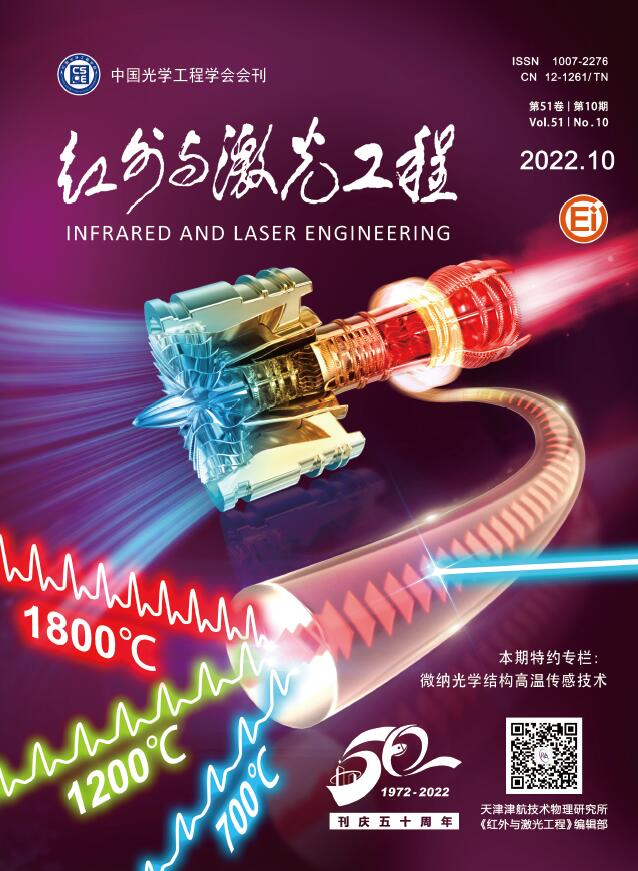-
随着红外制导与探测技术的发展,地面目标的红外辐射特性已成为军事研究的重点之一,可以利用目标与背景不同的红外辐射特性来实现对目标的探测、识别与追踪,亦可以通过降低目标与背景的红外辐射特性对比度来实现对目标的隐身和避藏[1-3],因此研究地面目标红外辐射特性对于军事目标的探测和隐身等具有重要的科学意义[4-6]。对于非合作地面目标而言,获取目标红外辐射特性数据的方法主要有实验测试方法和理论模型预测方法。实验测试方法代价巨大,难以对目标的状态、环境状态以及目标的红外辐射特性进行全面的测试,测试数据无法直接满足武器装备探测、跟踪、识别以及制导系统的需要,这给测试数据的使用带来了困难;理论模型预测方法在近几十年内取得了长足的发展,国内外已经开发了一系列较为成熟地面目标红外辐射特性模型,这些模型仿真结果的准确与否,与模型的输入参数关系非常密切。模型的输入参数包括目标详细的结构、材料、内部热源、动力系统、工作状态以及目标所处环境背景条件等[7]。针对非合作方目标,建模所需的参数往往都是涉密的,许多参数是无法获取的,因此参数的缺失给非合作目标红外辐射特性模型预测带来了很大的困难。但目标的红外测试数据可以视为是包含缺失参数以及所处的环境在内信息的综合作用的结果,因此可以利用目标的类似非合作红外测试数据来反演目标的部分或特定缺失参数以完成目标的精确建模。
对于目标的红外辐射特性建模来说,通过输入完整的参数理论计算获得目标的红外辐射特性数据为研究的正问题。目标的红外辐射特性建模离不开对目标温度场的建模,目标温度场建模是传热学问题,因此目标缺失参数反演可以类似归结到传热学领域的反问题研究,国内外对于传热反问题的研究已取得很大的研究进展并衍生出一系列效果良好的研究方法。人工智能方法[8,9]可以有效地反演传热反问题的相关参数,但此类方法计算量庞大且收敛性不好,难以实现参数反演的快速调节;模糊推理方法[10]计算步骤繁杂,不适用于地面目标的参数反演;优化方法中的梯度下降法[11-13]收敛速度快,既有较高的鲁棒性又可以实现多个缺失参数共同反演,适用于地面目标的参数反演。
前人的研究虽然深入且涉猎广泛,但国内外利用目标测试数据来反演其缺失参数的报道寥若晨星。基于上述研究背景,文中基于模型坦克的温度计算数据和类似非合作测试的简单CUBI模型[14]的红外辐射温度实测数据,结合共轭梯度法建立一套地面目标缺失参数反演与验证方法,针对两种目标来验证该方法的可行性。
-
地面目标的温度分布主要受外部环境及内部热交换的影响。图1给出了简单地面目标与地面背景在晴天天气条件下热边界示意图,主要包括太阳辐射、天空背景辐射、与空气的对流换热、自身辐射以及与地面的辐射换热等[15]。
-
简单地面目标的温度场求解主要考虑其自身热传导以及热边界条件。根据热力学第一定律和傅里叶导热定律,地面目标的瞬态温度控制方程为[15]:
式中: ρ为材料的密度;cp为材料的比热容;T为温度;t为时间;k为材料的导热系数。
-
简单地面目标的热边界条件主要包括太阳辐射、大气辐射、与空气的对流换热、自身辐射以及与地面的辐射换热,热边界方程为:
式中:Qtotal为总换热量;Esun为太阳辐射;Qsky为天空背景辐射;Qconvection为对流换热量;Eself为自身辐射量;Eground为地面辐射换热量。
-
晴天或多云天气情况下,地面目标表面会接收太阳辐射能,太阳辐射能与太阳高度角、方位角、海拔、季节、经纬度、时间、气象条件与大气透过特性等有关,可以分为太阳直接辐射、太阳散射辐射和地面反射的太阳辐射三部分[15-16]。计算公式如下:
垂直面上的太阳直接辐射为[16]:
水平面上的太阳散射辐射为[16]:
倾斜面上的太阳散射辐射为[16]:
对于倾斜面,来自地面反射的太阳辐射为[16]:
到达目标表面单位面积的太阳辐射为[16]:
式中:r为日地距离引起的修正值;E0为太阳常数;Pm为大气透明度;m为大气质量;c1,c2为经验系数,值取决于大气透明情况;h为太阳高度角;β为斜面倾角;θ为太阳入射方向与表面法向的夹角,αs为目标表面的太阳吸收率。
-
天空背景辐射属于长波辐射,晴天天空无云时,天空背景长波辐射为[16]:
式中:ε为目标的表面发射率;εa为天空背景等效发射率;σ为Stefan-Boltzmann常数,σ=5.67×10−8 W/(m2·K4),a0和b0为经验常数,式中取0.73和0.15;ea为近地面水汽压,单位为(kPa),是相对湿度rh和气温Ta的函数:
-
地面目标外表与周围环境空气的对流换热总是存在的,考虑到真实目标部件表面形状各异,目标外部经验对流换热系数与对流换热量为[16]:
式中:Ts为待求表面的温度;Ta为环境气温;v为目标移速与风速的矢量和。
-
目标温度高于绝对零度时会将热能转换为辐射能,发出向外的热辐射,根据Stefan-Boltzmann定律,目标自身热辐射的计算公式为[16]:
-
目标放置在地面上还会时刻收到来自地面的辐射换热,传热量的计算公式为:
式中:εg为地面的发射率;Tg为地面的温度。
-
目标的红外辐射由自身辐射和来自周围物体辐射的反射组成[16]。自身部分红外辐射能量采用普朗克公式积分得到,反射辐射部分主要包括单元表面对太阳辐射、天空及地面背景辐射以及其他单元表面辐射的反射,总辐射能量计算公式如下[16]:
式中:λ1,λ2分别为红外波段范围的下限和上限;C1为第一辐射常量,值为3.7419×10−16 W·m2;C2为第二辐射常量,值为1.4388×10−2 m·K;Hλ,j为来自第j个背景(天空、太阳、地物、相邻物体等)的有效辐射;N为背景的个数;ρ为目标对不同背景辐射的反射率。
-
根据前文描述,地面目标的红外辐射特性主要与目标的结构、材料参数、内部热源、动力系统、工作状态及环境条件有关。对于简单的冷静态条件下地面目标而言,目标的结构、热物性参数、工作状态和环境参数已知,内部热源和动力系统可以忽略,目标不同部件的厚度及表面涂层光学参数太阳吸收率和红外发射率通常未知,而这些因素会影响目标表面的温度分布和红外辐射特性分布,不同参数的对目标温度变化的贡献率也不同,需对此类参数进行影响程度研究及分析。
该节基于灵敏度理论和正交试验[15]研究了CUBI简单模型的厚度、太阳吸收率和红外发射率的贡献率,分析不同因素对目标温度的影响程度。表1为正交试验各因子水平表。
Influence factor Level 1 Level 2 Level 3 Thickness 4 7 10 Solar absorptivity 0.85 0.8 0.75 Infrared emissivity 0.95 0.9 0.85 Table 1. Level table of orthogonal test each factor
基于表1的正交试验各因子水平,设计正交试验,利用平方和分析法分析各个因素的影响程度。经统计计算,CUBI模型不同面不同因素的加权综合贡献率如图2所示。一般情况下,以综合贡献率大于2%的因素作为重要影响因子评判依据,由图可知选取的三个参数的贡献率均远远高于该评判标准,且太阳吸收率的贡献率超过50%。由上可知所取的三个参数在地面目标的建模过程非常重要,因此选取目标的厚度、太阳吸收率和红外发射率作为文中冷静态目标反演计算的缺失参数。
-
对于前述的地面目标系统传热反问题,地面目标的部件厚度及其表面涂层参数一般未知,而较易获取的为目标的温度或红外辐射特性测试数据,因而可以构造优化目标函数反演获取地面目标的缺失参数,目标函数为J(X):
式中:X=[h,α,ε]T为待反演的缺失参数,其中h表示部件厚度,α表示目标表面太阳吸收率,ε表示目标表面红外发射率;Y(X)=[Y(X)1,Y(X)2… Y(X)M]T为计算数据;Z=[Z1,Z2…ZM]T为测量数据;M为测量数据个数;T表示数据转置。
前述反问题等效于求解待反演参数X,使得J(X)达到最小值。
-
文中采用共轭梯度法完成目标缺失参数的反演,其基本思想为将共轭性与梯度下降法结合,利用已知点的梯度构造共轭方向,并沿共轭方向进行搜索求目标函数的极小值点。在文中研究问题中反演步骤为:首先提取未知参数下地面目标实测温度分布数据或红外辐射温度数据作为测量数据,然后假设一组初始猜测值,在该假设下通过正问题计算地面目标的温度或红外辐射特性分布,得到计算数据,根据测量数据与计算数据的差异构造目标函数,若目标函数收敛至设定值则输出该组参数,若不收敛则对参数进行修正重新计算正问题直至目标函数收敛至设定值。具体计算步骤如下所示[12]:
步骤①:设置n=0时的初始参数值X0,终止误差ζ>0;
步骤②:根据实测数据和初始参数计算数据构造并计算目标函数,检查是否小于终止误差,若满足条件则停止迭代,否则转往步骤③;
步骤③:根据目标函数计算共轭系数βn和梯度
$ \nabla $ J;式中:Fn为灵敏度系数矩阵。
步骤④:根据共轭系数和计算梯度等计算搜索方向dn与搜索步长αn:
步骤⑤:设置n=n+1,根据迭代公式Xn+1=Xn−αndn计算新的待反演参数Xn+1,返回步骤②。
-
为了验证上述反演方法的有效性,设计了某型号模型坦克目标仿真试验,计算其在自然环境条件下的冷静态温度分布。利用不同时刻与方位的温度计算数据对不同部件的厚度和太阳吸收率进行反演与验证,验证该反演验证方法的有效性与准确性。
-
如图3(a)所示为计算所用模型坦克几何模型图,模型包含坦克的基本部件,如前装甲、后装甲、炮台、炮管、车轮及履带、工具箱和裙板等。图3(b) 为计算正问题时使用的网格示意图,利用ICEM CFD软件对坦克目标进行网格划分,其中地面部分使用结构化网格,目标部分使用非结构化网格完成模型整体离散网格的划分。求解温度场时的控制方程与热边界条件如1.2节~1.3节所示,该节选取了2020年4月23日南京地区的环境及气象参数用于正问题的计算,其中气象条件采用气象观测站和太阳辐射观测站采集,两次采集间隔为60 s,具体各参数采集精度见4.1节,测试天气为多云,具体气象条件如图4所示。
-
坦克部件的厚度、表面光学涂层会极大地影响坦克的表面温度分布,该节结合俯视和右视两个方位的温度云图反演图中包含的坦克部件厚度及表面太阳吸收率。
首先基于专家知识及调研给出坦克目标不同部件的厚度及涂层的取值范围,确定各参数的约束条件,计算各参数在约束条件范围内的温度灵敏度,考虑到是仿真试验,因此各部件外表面设有相同的涂层,即具有相同的太阳吸收率。取各参数范围内接近取值上限的一组值作为真实参数,再取一组不同于真实参数的范围内值作为初始基准参数,分别通过正问题计算同一时刻的目标温度图像作为实测数据与初始计算数据。其中,参数反演的目标函数依据实测数据与计算数据的图像的像素值差异构造。
基于上述计算方法,对模型坦克目标的两个方位温度云图中包含的部件分别进行参数反演。取中午12时的温度分布数据用于参数反演,图5(a)和图5(b)分别为俯视和右视方向坦克模型的初始计算温度云图,其中包含的部件分别有前装甲、炮台、后装甲、炮管和工具箱以及炮台、炮管、裙板和履带轮胎,初始取值以及约束条件范围如表2所示。

Figure 5. (a) The top-view azimuth temperature nephogram of tank; (b) The right-view azimuth temperature nephogram of tank
Part Front armor/mm Fort/mm Rear armor/mm Gun barrel/mm Value 50 40 30 15 Value range 45-60 35-48 25-36 10-20 Part Toolbox/mm Skirt armor/mm Tracks tires/mm Solar absorptivity Value 5 5 36 0.6 Value range 2-10 2-10 30-48 0.5-0.7 Table 2. Initial parameters and constraint range of each component of the tank target
图6(a)和图6(b)为俯视方位和右视方位各参数的反演迭代曲线图。从图中可以看出,初值一定的情况下,不同方位图像包含的部件反演的参数值很快达到稳定。
-
表3与表4为基于12时坦克目标温度分布云图的俯视方位与右视方位参数反演结果,由表可以看出,各部件厚度反演值与真实值的误差集中在10%以内且最高不超过15%,太阳吸收率误差不超过5%,表明该方法具有很高的反演精度。
Part Initial parameter value Real parameter value Inversion parameter value Error Front armor/mm 50 59 58.537 −0.79% Fort/mm 40 46 47.926 4.19% Rear armor/mm 30 35 34.791 −0.60% Gun barrel/mm 15 19 17.888 −5.85% Toolbox/mm 5 8 6.904 −13.70% Solar absorptivity 0.6 0.5 0.496 −0.80% Table 3. Inversion results of top view azimuth parameter
Part Initial parameter value Real parameter value Inversion parameter value Error Skirt armor/mm 5 8 7.183 −10.21% Fort/mm 40 46 49.073 6.68% Tracks & tires/mm 36 45 42.984 −4.48% Gun barrel/mm 15 19 17.685 −6.92% Solar absorptivity 0.6 0.5 0.494 −1.20% Table 4. Inversion results of right view azimuth parameter
为了进一步在实际应用中研究反演误差对计算结果的不确定性影响,该节将基于12时反演出的两组缺失参数分别代入计算模型计算得14时的目标温度云图与多个时间点的典型部件表面测点的温度值,结合真实参数下的典型时刻温度云图与多时间点温度计算数据,通过评价其温度云图结构相似度[4]与典型部件的温度误差来评价反演结果的准确性。
图7(a)和图7(b)为俯视方位的14时真实参数与反演参数的温度云图,图7(c)和图7(d)为右视方位的14时真实参数与反演参数的温度云图。由图可以看出,在相同的温度区间内,俯视方位与右视方位温度云图中的各部件温度趋势除炮台部件的温度趋势略有不同外几乎趋于一致。经图像结构相似度SSIM指标验证, 俯视与右视方位真实参数图像与反演参数图像的结构相似度均超过95%,证明该方法下缺失参数值的反演误差对于目标红外辐射温度图像的不确定影响很小。

Figure 7. Calculation of temperature nephogram at 14 o'clock. (a) Temperature nephogram of top-view azimuth real parameters; (b) Temperature nephogram of top-view azimuth inversion parameters; (c) Temperature nephogram of right-view azimuth real parameters; (d) Temperature nephogram of right-view azimuth inversion parameter
为了进一步确定反演误差对多时间段温度计算结果的影响,选取了前装甲、工具箱、炮台、炮管等部件,计算其真实参数下与反演参数下的全天温度变化特性,通过对比其温度误差确定反演误差对计算结果的影响。图8(a)和图8(b)为基于俯视方位反演结果的真实参数与反演参数的前装甲与工具箱部件的全天温度计算对比图,图8(c)和图8(d)为基于右视方位反演结果的真实参数与反演参数的炮台与炮管部件的全天温度计算对比图。可以看出,不同的典型部件真实参数与反演参数的计算温度变化特性趋于一致,且全天温度误差最高不超过±1 K,证明该方法下缺失参数值的反演误差对于目标多时间段的温度计算的影响很小,证明了该反演方法的准确性。

Figure 8. Calculation of temperature changes throughout the day. (a) Comparison diagram of the calculated temperature of the front armor; (b) Comparison diagram of the calculated temperature of the toolbox; (c) Comparison diagram of the calculated temperature of the fort; (d) Comparison diagram of the calculated temperature of the gun barrel
-
为了进一步验证上述反演方法的有效性,设计了CUBI模型目标测试试验。利用长波红外热像仪测试目标在自然环境条件下典型时刻的冷静态的红外辐射温度数据,结合红外辐射计算模型,通过目标不同时间与方位的红外实测数据与计算数据对目标的厚度、太阳吸收率以及红外发射率进行反演与验证,验证该反演算法在真实目标条件下的有效性与准确性。
-
图9(a)所示为研究的标准CUBI目标模型可见光图,模型高、长均为0.6 m,宽0.3 m,采用Q235钢板焊接而成,每个面均抛光打磨,加工误差可以忽略。钢板的热物性参数:密度为7850 kg/m3,比热容为540 J/(kg·K),导热系数为44 W/(m·K),模型表面均匀涂绿漆,各表面的部件厚度和涂层参数一致。试验地点位于南京理工大学电光学院附近草地,地理位置位于东经118°85′,北纬32°03′。试验时间为2021年4月9日,期间天气为晴天。试验时将CUBI模型较低的阶梯面朝向正北方向,利用Agilent 34972 A型号数据采集仪与12个K型热电偶采集模型典型测点测试温度,试验时模型表面中心各布置一个热电偶用于采集表面中心温度,热电偶采集时间间隔为60 s,测温精度为0.01 ℃。利用FLUKE TiX580型号长波红外热像仪测试早、中、晚时间点目标7.5~14 μm长波红外辐射温度图像数据,测温精度为0.01 K。试验期间的气象参数利用气象观测站及太阳辐射观测站采集,采集间隔均为60 s,其中,风速采集精度为0.1 m/s,气温采集精度为0.1 ℃,环境湿度采集精度为0.1%,太阳直射与散射辐射采集精度为0.01 W/m2。
-
该节研究的CUBI目标计算条件根据试验情况给出,图9(b)为正问题使用的物理计算模型。利用ICEM CFD软件对模型进行网格划分,地面与CUBI模型均采用结构化网格;求解温度场时的控制方程和边界条件如1.2节~1.3节所示;最后通过模型表面温度场与气象参数编程计算其红外辐射温度分布。其中,气象参数为2021年4月9日气象站和太阳辐射观测站实测所得,试验期间气象参数的变化特性如图10所示。
-
根据前文分析,自然环境冷静态条件下CUBI的红外辐射特性主要受材料厚度,表面涂层太阳吸收率以及红外发射率影响,该节利用实测红外辐射温度数据结合计算模型对以上三个参数进行反演。
首先对目标表面绿色涂层的光学参数及材料厚度进行专家知识调查预估,给出各参数的合理范围;其次,猜测一组合理的值作为初始基准值,通过正问题计算求解目标某一时刻的红外辐射温度作为初始计算数据;最后,提取同一时刻同一方位目标实测红外辐射温度数据,依据实测数据与初始计算数据之间的差异构造目标函数用于反演计算。
经调研,CUBI模型表面绿色涂层的太阳吸收率与红外发射率均在0.65~0.95之间,模型厚度范围在4~10 mm之间,在此范围内计算各参数的温度灵敏度用于反演计算。初值分别取太阳吸收率α=0.8,红外发射率ε=0.95,考虑到加工精度的影响,CUBI模型的初始厚度取5 mm。如图11(a)所示为文中反演所用长波红外实测温度图,测试时间为2021年4月9日9时,测试方向为正北方向,测试时红外热像仪的发射率设置为预估发射率0.95,测试图像数据均已经过传感器温度标定与大气传输效应处理,取其表面16个温度点数据用于反演计算。同样地,计算模型取相同的位置及个数的数据,图11(b)为取点位置标注图。
将上述计算条件及实测数据用于参数反演过程中,图12为参数反演迭代过程的曲线图。可以看出,在固定初值的情况下,该反演方法可以很快地达到稳定值,稳定值为α=0.7323,ε=0.9146,h=7.2836 mm。
-
为了验证该组反演参数的准确性与真实性,将基于9时正北方向实测数据反演得到的参数代入计算模型计算得到另一方位14时的红外辐射温度图像数据与白天时段多个时间点的典型测点计算温度特性变化数据,结合相同时间同一方位的实测红外辐射温度图像数据典型测点的热电偶采集数据,通过对比其典型时刻红外温度分布与典型测点多时间点的温度差异来验证反演的参数。
图13(a)为2021年4月9日14时正东方向拍摄的长波红外辐射温度图,其中,输出此图像时发射率数据校准为反演得到的发射率0.9146,图13(b)为去除背景处理后的目标表面实测红外辐射温度图,图13(c)为计算目标红外辐射温度图。由图可以看出,相同的温标下,实测温度云图与计算温度云图温度趋于一致,证明该反演参数下的计算模型具有很高的精度,参数亦接近真实值。

Figure 13. (a) Measured long wave infrared temperature at positive east position at 14 o'clock on April 9, 2021; (b) Measured infrared temperature map of positive east position of target; (c) Calculated infrared temperature map of positive east position of target
为了进一步确定反演参数与真实目标参数的模型计算误差,选取了CUBI上方小正方体的东、北和上三个目标表面,计算其中心点在白天时段多个时间点的温度,通过对比反演参数下的计算温度与热电偶实测温度的误差来确定真实参数反演的精度。图14(a)~图14(c)分别为东、北与上表面中心的8:00~16:00的计算与实测温度变化特性及其误差图。由图可以看出,在所选时间内,各表面的计算温度值与热电偶实测温度值变化趋势趋于一致,且各表面温度点的误差最高不超过±2 K,表明了该方法下的参数反演值与参数真实值误差很小,验证了该方法的准确性与有效性,同时也说明了正问题中的经验模型与参数具有很好的实用性与较高的准确度。
-
文中基于地面目标的仿真试验与实测红外温度数据,结合共轭梯度法提出了一种地面目标缺失参数的反演与验证方法,针对模型坦克与CUBI模型两种地面目标来验证该方法的可行性。得到的主要结论如下:
(1)基于地面目标仿真试验或者实测数据,利用共轭梯度法可以有效地反演红外建模缺失参数,反演的参数值可以在很少的步数内达到迭代稳定;
(2)反演的参数模型计算温度值与仿真试验或实测温度值随时间的变化特性趋于一致,两种地面目标典型测点的单时刻计算温度与测试温度差异最高不超过2 K,证明该反演方法与计算模型具有很高的准确性;
由此可见,该套方法在地面目标缺失参数反演与验证方面具有很好的有效性与准确性,可以为地面目标的精确建模提供新的参数获取思路与方法,为非合作目标的参数反演提供方法支撑。文中着重研究冷静态下的地面目标红外辐射特性建模参数,未考虑地面目标的热静态或热动态等工况,未来可以利用此方法建立更多工况条件下的反演与验证计算模型,获取更多的建模所需参数。
Inversion and model validation method of missing parameters in infrared modeling of ground targets
doi: 10.3788/IRLA20220033
- Received Date: 2022-01-11
- Rev Recd Date: 2022-03-16
- Available Online: 2022-11-02
- Publish Date: 2022-10-28
-
Key words:
- ground target /
- infrared radiation characteristics /
- missing parameter /
- inversion and verification
Abstract: The modeling of infrared radiation characteristics of ground targets requires relatively complete parameters. For non-cooperative targets, many related parameters are difficult or cannot be directly obtained by testing methods. The lack of parameters brings great difficulties to the prediction of target infrared radiation characteristics. The infrared test data of the target can be considered as the result of the comprehensive action of information including all parameters and the environment. Therefore, the test data of the target can be used to invert some important missing parameters. For cold static target, the possible missing parameters of ground target modeling are analyzed firstly, and the value ranges of the missing parameters are estimated through research and expert knowledge, etc. Based on the sensitivity theory and orthogonal experiment method, the influences of the missing parameters on target characteristics are studied, and the main missing parameters are determined, including material thickness, solar absorptivity and emissivity of the material surface. Then, based on the ground target simulation test data or measured data, combined with the conjugate gradient method, a method for inversion and model verification of ground target infrared modeling missing parameters is proposed. Finally, two examples are used to verify the method. The results show that the calculated temperature of typical measuring points after inversion of missing parameters using this method is highly consistent with the actual temperature variation characteristics, and the data error of temperature at different times does not exceed 2 K at most. The research shows that the method has good accuracy, and it can be extended and applied to the inversion of missing parameters in the infrared modeling of non-cooperative targets and the prediction of infrared radiation characteristics in the future.





















 DownLoad:
DownLoad:












